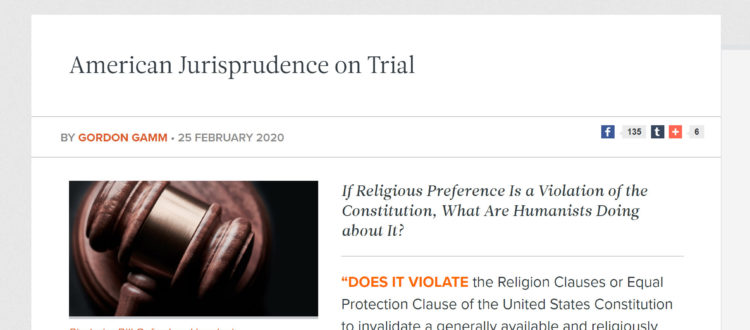A Helpful Primer on Secular Government
An article in the latest edition of The Humanist Magazine, “American Jurisprudence on Trial,” by Gordon Gamm, provides a concise and helpful history of the separation of religion and government and the key issues currently being litigated around the notion of a secular government.
Gamm is a longtime leader in both the Humanist and Humanistic Judaism movements. As a retired attorney, his involvement has included providing extensive legal expertise to help ensure that humanists – along with all other Americans – receive equal protection of and from religion, as guaranteed by the First Amendment of the Constitution.
In the article, Gamm answers why there is a separation of church and state, which is ultimately to foster greater harmony. He writes:
The Constitution isn’t godless because it’s hostile to religion or God; it’s godless because any preference for God or religion necessarily reflects one or another’s God or religious concept. There are over two thousand God concepts and over ten thousand religions in the world today, not to mention the many more interpretations of numerous holy books, each alleged to have been written or inspired by God. These differences have historically been the basis for war and conflict that undermines civil discourse and peaceful coexistence. Thus, if two or more people are equally convinced that their God or religion is infallible but disagree with each other, then there is no evidence from experience to resolve their difference. This leads to religious partisanship and societal discord, the antithesis of peaceful resolution.
American Jews are specifically addressed in the piece, when Gamm offers a sampling of faith-based beliefs “immune to rational discourse” that could create conflict should the government play favorites. He went with arguably the most controversial Jewish practice: “Some 1.6 billion Muslims and fourteen million Jews believe in cutting the foreskins of baby boys in service of their faith.” For those steeped in tradition, such rituals seem familiar and understood. When listed together with ideas from other faiths, like Mormons believing ancient Hebrews buried gold tablets in America as a new bible, it demonstrates how such beliefs are not logically explained.
Toward the end of the article, Gamm offers a broad definition of secularism as it relates to government, and explains how it fosters freedom and fairness. Woven throughout the piece are references to two recent Supreme Court cases, the Bladensburg Cross case and Espinoza v. Montana Department of Revenue.
Overall, these few pages offer a detailed starting-point for anyone seeking to quickly get up-to-speed about – and be able to advocate for – the separation of church and state.

